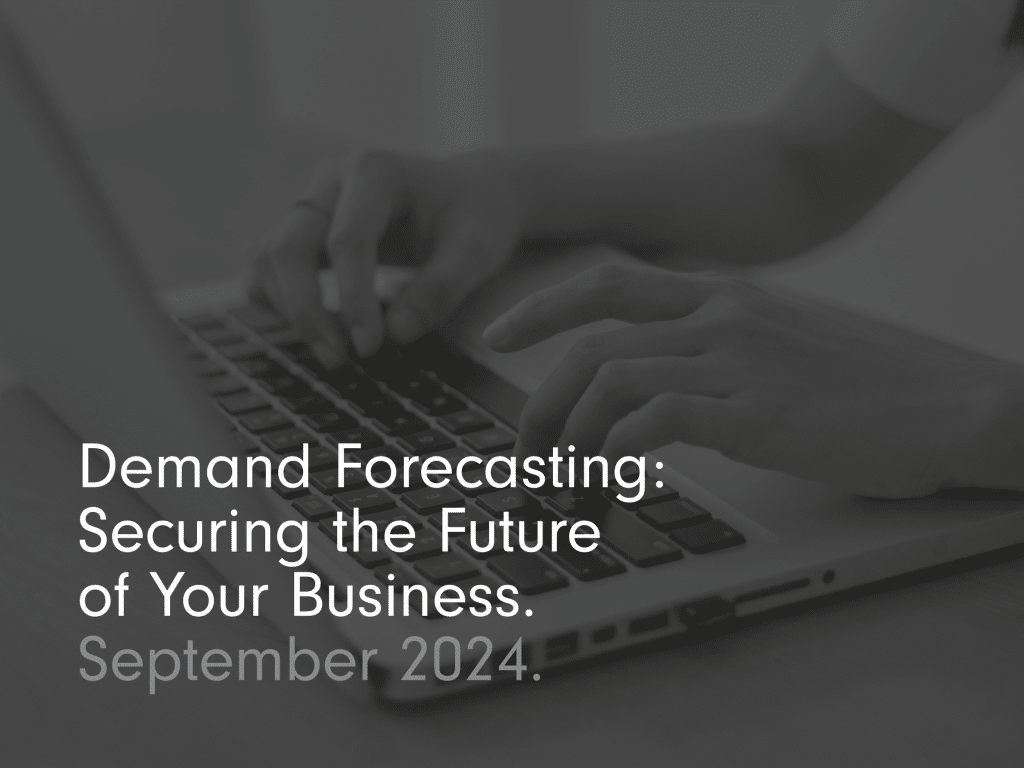Demand Forecasting: Securing the Future of Your Business.

Demand forecasting is a key tool for e-commerce businesses and supply chain managers. It helps them predict future customer demand.
This information guides decisions and improves inventory levels. This guide will explain demand forecasting. You’ll learn why it’s important, the methods used, and tips to improve accuracy.
Understanding Demand Forecasting.
Demand forecasting is predicting how much customers will want to buy products or services in the future. This involves looking at past sales data, studying the market, and considering other factors to make smart guesses. Accurate demand forecasting is important because it helps businesses manage their inventory, cut costs, and keep customers happy. By predicting demand, companies can make better business decisions and stay competitive in a fast-changing market.
The Role of Demand Forecasting.

For both e-commerce and supply chain management, demand forecasting is important. In e-commerce, it helps manage inventory levels, reduce running out of stock, and ensures timely deliveries. By predicting demand accurately, businesses can have the right amount of stock, avoiding too much or too little. This reduces costs and improves customer satisfaction by keeping products available.
In supply chain management, demand forecasting helps improve efficiency. It allows managers to plan production schedules, allocate resources, and manage logistics better. Accurate forecasting also helps identify potential problems and fix them before they become serious.
Demand Forecasting Methods.

Demand forecasting is pivotal in making informed business decisions. Below, we elaborate on various methodologies that businesses can leverage to enhance their forecasting accuracy:
Historical Data Analysis
Historical data analysis involves examining past sales data to identify trends, patterns, and seasonal variations in demand. By analysing historical performance, businesses can project future demand with a certain degree of accuracy. This method is relatively straightforward and is best suited for products with stable demand patterns.
Market Research
Market research means collecting information from consumers and the market. This includes surveys, focus groups, and trend analysis. Market research helps us understand what customers like and outside factors that affect demand. Although it takes more time, it provides valuable insights that can support numerical data.
Machine Learning Algorithms
Machine learning algorithms can process vast amounts of data and identify complex patterns that are often not apparent through traditional methods. Algorithms like regression analysis, neural networks, and time series forecasting are commonly used. These advanced techniques allow for high levels of accuracy and adaptability, making them suitable for dynamic and volatile market conditions.
Econometric Models
Econometric models look at economic indicators like GDP, inflation rates, and unemployment levels to predict demand. By connecting economic factors with sales data, businesses can see how these factors affect their operations. This approach is especially helpful for industries that are sensitive to economic changes.
Comparative Analysis
Comparative analysis involves benchmarking performance against competitors or industry standards. By understanding how similar products perform in the market, businesses can gauge potential demand for their own offerings. This method is useful in highly competitive industries where external market forces significantly influence demand.
Causal Models
Causal models show how different factors affect consumer demand. We look at things like marketing, price changes, and promotions. This helps us understand how these factors impact demand. Businesses can use this method to predict how changes will affect future sales.
In e-commerce and supply chain management, using a mix of these methods can improve demand forecasting. By integrating these approaches with advanced tools like Valogix, businesses can effectively anticipate market needs, while also boosting operational efficiency and customer satisfaction.
Importance of Accurate Forecasts in Inventory Management and Business Decisions.

Accurate demand forecasts are important for managing inventory and making smart business decisions. When businesses accurately predict future demand, they can maintain the right amount of inventory. This helps them avoid running out of stock or having too much. This lowers storage costs and improves cash flow.
Demand forecasts do more than just manage inventory. They help make better business decisions. Forecasts provide insights into customer wants and market trends.
This helps businesses create effective marketing plans, schedule production, and use resources efficiently. In the end, accurate demand forecasting helps businesses stay competitive and adapt to market changes.
Demand forecasting model is a useful tool for businesses of all sizes. It uses historical data, market trends, and statistical analysis to predict future demand. This allows businesses to plan ahead and make informed decisions.
Short-Term Demand Forecasting vs. Long-Term Demand Forecasting.

Short-term and long-term demand forecasts serve different purposes and timeframes.
Short-Term Demand Forecasting
Short-term demand forecasting is about predicting demand for a short time, usually from a few days to a few months. This is important for daily tasks like restocking inventory, planning production, and handling promotions. Short-term forecasts help businesses quickly adapt to changing market conditions and what customers want.
Long-Term Demand Forecasting
Long-term demand forecasting predicts how much demand there will be for a product or service over several months to years. This forecasting is important for planning big things. It helps decide how much to produce, create new products, and make investment decisions.
Businesses can use long-term forecasts to understand market trends. This helps them prepare for future growth and any challenges they might face. It helps companies plan ahead and be prepared for what’s coming.
What Influences Customer Demand?

Understanding what affects customer demand is important for businesses that want to improve their operations and meet market needs. Many factors can influence how consumers buy products. Recognising these factors can help e-commerce companies adjust their strategies:
Economic Factors
Economic conditions such as income levels, employment rates, and inflation play a significant role in shaping customer demand. During periods of economic growth, disposable incomes tend to rise, leading to increased consumer spending. Conversely, economic downturns can result in reduced demand as consumers become more cautious with their expenditures.
Seasonal Trends
Seasonality plays a big role in demand patterns. For example, retail businesses usually see a sales boost during the holiday season, while some products become more popular at certain times of the year. By understanding and predicting these cycles, businesses can plan their inventory and marketing efforts more effectively.
Technological Advancements
The fast pace of technology changes what consumers want and how they act. New technologies can create demand for new products, while others become outdated. Keeping up with tech trends helps businesses adapt quickly and match their products to what the market needs.
Marketing and Promotions
Marketing efforts, like advertising campaigns, discounts, and special promotions, affect customer demand. Good marketing strategies create awareness, spark interest, and boost sales. Companies that plan their marketing well can greatly influence what consumers decide to buy.
Social and Cultural Influences
Changes in social norms and cultural trends can also affect demand. For example, the growing emphasis on sustainability has led to increased demand for eco-friendly products. Understanding the social and cultural context in which customers operate enables businesses to better cater to their values and preferences.
Competitor Actions
The activities of competitors, such as product launches, pricing strategies, and marketing campaigns, can impact customer demand. Staying informed about competitor actions and market dynamics helps businesses remain competitive and adjust their strategies accordingly.
Demographic Changes
Shifts in demographic factors, including age, gender, education levels, and family structures, influence demand patterns. For instance, an ageing population may increase demand for healthcare products and services, while a younger demographic may drive demand for technology and entertainment products.
By meticulously analysing these factors, businesses can gain a comprehensive understanding of what drives customer demand. This knowledge empowers them to make informed decisions, optimise their product offerings, and ultimately achieve greater market success.
Forecast Demand: Examples.

Retail Industry: Analysing Historical Sales Data
Retailers often use past sales data to predict future demand. By looking at patterns in previous sales, they can spot trends and forecast consumer behaviour.
For example, a clothing store might check past sales during the holiday season. This helps them decide how much stock to order for the next year. Retailers use past sales data to predict future demand. They look for patterns in previous sales to identify trends and forecast consumer behaviour.
For example, a clothing store might review past sales from the holiday season. This information helps them determine how much stock to order for the next year. They can also predict demand for specific items, like winter clothes, and adjust their inventory accordingly.
Technology Sector: Leveraging Social Media Analytics
Tech companies use social media analytics to predict demand. By watching discussions and feelings on Twitter, Facebook, and Instagram, they can see what customers like and spot new trends. For example, a phone maker might follow social media talk about new features or rival launches to guess future demand for their products. This real-time data helps businesses act quickly to meet market needs.
Valogix Enhances Demand Forecasting for E-commerce Businesses.

Valogix is a strong tool for inventory planning and forecasting. It helps e-commerce businesses optimize their stock needs. This leads to better cash flow. With its advanced features and user-friendly interface, Valogix makes demand forecasting more accurate and efficient.
Key Features of Valogix
Valogix offers several key features that enhance demand forecasting for e-commerce businesses:
- Automated Planning: Valogix automates the inventory planning process, including forecasting, replenishment, and optimization. This reduces the time and effort required for manual planning.
- Exception-Based Alerts: Valogix provides exception-based alerts, notifying users of potential future issues. This helps businesses address problems before they become critical.
- Visibility and Control: Valogix offers network balance details on-screen and easily viewable, providing visibility and control over all items and locations.
- Cost Savings: Valogix optimizes inventory levels. This helps businesses reduce out-of-stock situations. It improves customer satisfaction and increases sales. This leads to significant cost savings and a rapid return on investment.
Benefits of Using Valogix
Businesses that use Valogix for demand forecasting can expect several benefits:
- Improved Planning Efficiency: Valogix reduces planning time by 40% to 85%, depending on the size of the operation. This frees up valuable time for other important tasks.
- Increased Item Availability: Valogix reduces out-of-stock situations by 15% to 30%. This helps businesses improve customer satisfaction and boost sales.
- Reduced Inventory Costs: Valogix users report safely reducing inventory by 20% to 40%. This leads to lower carrying costs and overhead.
- Enhanced Decision Making: With accurate forecasts and real-time data, Valogix supports better business decisions and strategic planning.
Tips for Improving Forecast Accuracy and Decision-Making.

Improving forecast accuracy is crucial for effective demand forecasting and informed decision-making. Here are some tips to help you achieve more accurate forecasts:
Multiple Data Sources
Relying on just one data source can make your forecasts less accurate. Instead, use different sources like past sales data, market research, and customer feedback to better understand demand patterns.
Advanced Evaluation Tools
Tools like machine learning and regression analysis can help find complex patterns in your data. These tools can make your forecasts more accurate and help you make better decisions.
Keep Monitoring and Adjusting Forecasts
Demand forecasting isn’t a one-time thing. Keep an eye on your forecasts and adjust them with new data and market changes. This helps you stay flexible and respond to customer demand.
Work with Key Stakeholders
Get key teams like sales, marketing, and supply chain involved in the forecasting process. Working together considers all important information and aligns forecasts with business goals.
The Future of Demand Forecasting.

The future of demand forecasting looks promising. Advances in technology and data analytics are helping us make more accurate and efficient predictions. Here are some trends shaping the future of demand forecasting:
Integration of AI and Machine Learning
Artificial intelligence and machine learning will play a big role in demand forecasting. They analyze large amounts of data, find complex patterns, and make accurate predictions. By using AI and machine learning in forecasting, businesses can stay ahead of the competition. They can also respond quickly to changing market conditions.
Real-Time Data Analytics
Real-time data analytics is becoming more important for demand forecasting. By using real-time data, businesses can make better decisions. They can also adjust their forecasts to match current market conditions. This helps them stay agile and respond quickly to customer demand.
Enhanced Collaboration and Communication
Successful demand forecasting will rely on collaboration and communication. Businesses must work with supply chain partners, customers, and stakeholders to ensure accurate forecasts. Better collaboration will help optimize operations and improve efficiency.
Demand forecasting is important for e-commerce businesses and supply chain managers. It helps them predict future demand accurately. This allows businesses to optimize inventory levels, cut costs, and boost customer satisfaction. With tools and techniques like Valogix, businesses can make better forecasts and smarter decisions.
Conclusion.
Accurate demand forecasting is crucial in e-commerce. Tools like Valogix help businesses manage inventory, reduce costs, and keep customers happy. With AI, machine learning, and real-time data, companies can stay ahead and make smart choices.
Monitoring and teamwork are vital to adapt to market changes. These techniques enhance efficiency and growth for e-commerce companies.
Frequently Asked Questions.
Demand forecasting predicts future customer demand for products or services using past data and market research.
Demand forecasting helps e-commerce businesses optimize inventory levels, reduce stockouts, and ensure timely deliveries, leading to cost savings and improved customer satisfaction.
Valogix is an inventory planning and forecasting software. It automates the forecasting process and provides real-time data insights. This helps businesses optimize inventory levels, reduce costs, and improve customer satisfaction.
Common methods of demand forecasting include historical data analysis, market research, and machine learning algorithms.
Businesses can improve forecast accuracy by using multiple data sources, implementing advanced evaluation tools, consistently monitoring and adjusting forecasts, and collaborating with key stakeholders.
Short-term demand forecasting predicts demand over days to months and is vital for daily operations. Long-term forecasting predicts demand over months to years and is important for strategic planning.